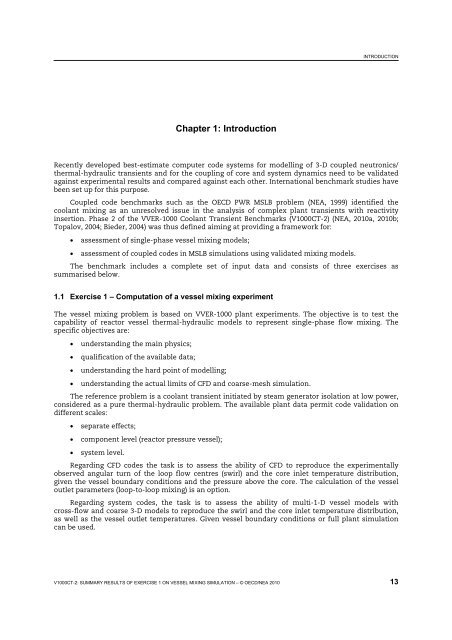VVER-1000 Coolant Transient Benchmark - OECD Nuclear Energy ...
VVER-1000 Coolant Transient Benchmark - OECD Nuclear Energy ...
VVER-1000 Coolant Transient Benchmark - OECD Nuclear Energy ...
Create successful ePaper yourself
Turn your PDF publications into a flip-book with our unique Google optimized e-Paper software.
Chapter 1: Introduction<br />
INTRODUCTION<br />
Recently developed best-estimate computer code systems for modelling of 3-D coupled neutronics/<br />
thermal-hydraulic transients and for the coupling of core and system dynamics need to be validated<br />
against experimental results and compared against each other. International benchmark studies have<br />
been set up for this purpose.<br />
Coupled code benchmarks such as the <strong>OECD</strong> PWR MSLB problem (NEA, 1999) identified the<br />
coolant mixing as an unresolved issue in the analysis of complex plant transients with reactivity<br />
insertion. Phase 2 of the <strong>VVER</strong>-<strong>1000</strong> <strong>Coolant</strong> <strong>Transient</strong> <strong>Benchmark</strong>s (V<strong>1000</strong>CT-2) (NEA, 2010a, 2010b;<br />
Topalov, 2004; Bieder, 2004) was thus defined aiming at providing a framework for:<br />
• assessment of single-phase vessel mixing models;<br />
• assessment of coupled codes in MSLB simulations using validated mixing models.<br />
The benchmark includes a complete set of input data and consists of three exercises as<br />
summarised below.<br />
1.1 Exercise 1 – Computation of a vessel mixing experiment<br />
The vessel mixing problem is based on <strong>VVER</strong>-<strong>1000</strong> plant experiments. The objective is to test the<br />
capability of reactor vessel thermal-hydraulic models to represent single-phase flow mixing. The<br />
specific objectives are:<br />
• understanding the main physics;<br />
• qualification of the available data;<br />
• understanding the hard point of modelling;<br />
• understanding the actual limits of CFD and coarse-mesh simulation.<br />
The reference problem is a coolant transient initiated by steam generator isolation at low power,<br />
considered as a pure thermal-hydraulic problem. The available plant data permit code validation on<br />
different scales:<br />
• separate effects;<br />
• component level (reactor pressure vessel);<br />
• system level.<br />
Regarding CFD codes the task is to assess the ability of CFD to reproduce the experimentally<br />
observed angular turn of the loop flow centres (swirl) and the core inlet temperature distribution,<br />
given the vessel boundary conditions and the pressure above the core. The calculation of the vessel<br />
outlet parameters (loop-to-loop mixing) is an option.<br />
Regarding system codes, the task is to assess the ability of multi-1-D vessel models with<br />
cross-flow and coarse 3-D models to reproduce the swirl and the core inlet temperature distribution,<br />
as well as the vessel outlet temperatures. Given vessel boundary conditions or full plant simulation<br />
can be used.<br />
V<strong>1000</strong>CT-2: SUMMARY RESULTS OF EXERCISE 1 ON VESSEL MIXING SIMULATION – © <strong>OECD</strong>/NEA 2010 13

















